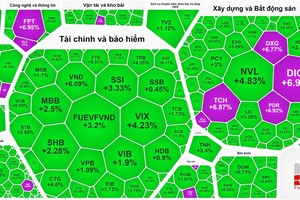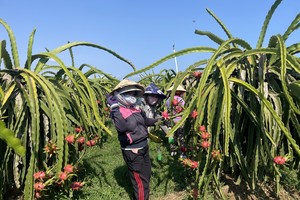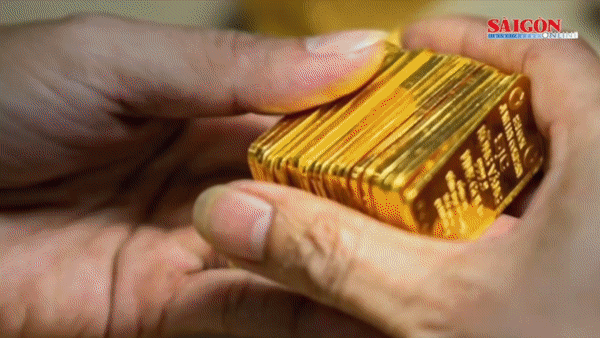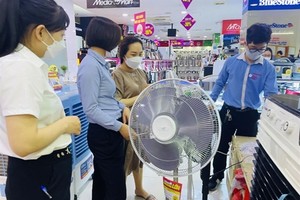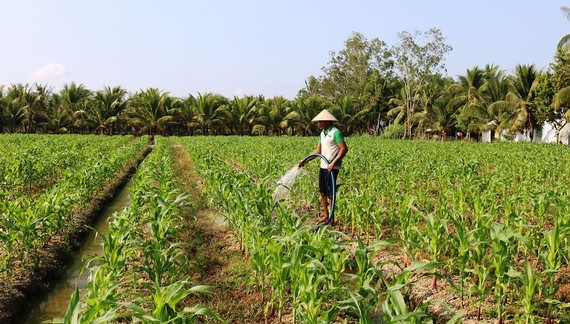
Mr. Thach Sach, a farmer in Thong Hoa Commune in Cau Ke District in Tra Vinh Province, said that his 6,000-square-meter cornfield has been sowed for more than one month, by taking the initiative in the source of fresh water, despite the severe drought, his cornfield is not affected. Currently, the price of corn fluctuates from VND25,000 to VND30,000 per 14 items, after deducting costs, farmers earn a profit of nearly VND5 million per 1,000 square meters, much higher than growing rice, and the cultivation duration is also shortened to 70 days per crop.
Also reducing the rice-growing area to switch to grow vegetables, Mr. Nguyen Hoang Khoi, a farmer in Thien My Commune in Tra On District in Vinh Long Province, pointed at his lush green 3,000 square meters of cucumbers, saying that the advantage of growing cucumbers is short cultivation duration. Cucumbers are ready for harvest within just 32 days and a crop takes only 60 days. The cucumber yield is around 3-4 tons per 1,000 square meters, with a price of VND5,000 per kilogram upwards, farmers will definitely have profits.
According to the People’s Committee of An Giang Province, in recent years, the province has encouraged reducing the rice-growing area. In 2013, the province grew more than 641,340 hectares of rice, the figure now has dropped to below 620,000 hectares. Most of the altered areas were prioritized for the cultivation of fruit trees and vegetables, of which, some centralized vegetables areas were established, including nearly 700 hectares in Cho Moi District, and 3,200 hectares in Tri Ton District. Currently, the province continues to develop specialized farming areas for baby corn with 2,000-2,500 hectares, hybrid corn with 4,100 hectares, soybean with 450 hectares, and Japanese okra with 500 hectares. Reasonable crop alteration has helped the provincial total agricultural production value to reach VND183 million per hectare, higher than the level of VND120 million per hectare in 2015.
The Ministry of Agriculture and Rural Development (MARD) said that reducing rice-growing areas is encouraged in order to increase the income of farmers. Accordingly, the altered rice-growing area in the winter-spring rice crop in the Mekong Delta was more than 41,230 hectares. The most grown vegetables included corn, peanut, soybean, sesame, and vegetables. Meanwhile, the area of fruit trees, including orange, pomelo, tangerine, dragon fruit, and longan, tended to increase because of high economic efficiency.
Mr. Le Thanh Tung, Deputy Director of the Department of Crop Production, said that vegetables grown on the rice-growing area gained revenue of around VND178 million per hectare and a profit of VND113 million per hectare; fruit trees earned an estimated revenue of VND607 million per hectare, and a profit of VND207 million per hectare. All these crops are more efficient than rice. Shortly, the department will continue to collaborate with provinces to alter inefficient rice-growing areas and saltwater intrusion affected areas to grow other crops that are suitable for each place to help farmers to raise their income and ensure the sustainable development goals.
The Department of Agriculture and Rural Development said that last summer-autumn crop, farmers grew vegetables on rice land, collecting a revenue of VND143 million per hectare and a profit of VND88 million per hectare; watermelon cultivation brought revenue of VND169 million per hectare and a profit of VND70 million per hectare. Based on these results, this summer-autumn crop, the province has encouraged farmers to continue to switch crops to increase the production value.
In Dong Thap Province, last summer-autumn crop, farmers replaced rice by purple sweet potato, raking a revenue of VND200 million per hectare and a profit of VND95 million per hectare; chili cultivation gave a revenue of up to VND418 million per hectare and a profit of more than VND243 million per hectare, much higher than growing rice. Many farmers in the Mekong Delta have also applied cultivation models following the VietGAP standards, high-tech farming, or the models of growing orchids, decorating flowers, and ornamental plants that bring high income.
The MARD recognized that most provinces in the Mekong Delta got high efficiency by switching crops, improving the income for farmers, saving water, especially when the situation of drought and saltwater intrusion is more intense. Crop switching also helps to improve the soil and reduce pests and diseases. However, the current shortcomings are that irrigation has not been appropriate; some altered crops have weak competitiveness due to small-scale production, difficult mechanization, increased input materials, and high-cost prices. Especially, consumption has not been stable because of a lack of connection between farmers and enterprises. Policies to encourage crop switching on rice-growing land have also not been strong enough.
These are shortcomings that need to be resolved timely to help farmers to bravely change crops to increase the production value in the future.
Also reducing the rice-growing area to switch to grow vegetables, Mr. Nguyen Hoang Khoi, a farmer in Thien My Commune in Tra On District in Vinh Long Province, pointed at his lush green 3,000 square meters of cucumbers, saying that the advantage of growing cucumbers is short cultivation duration. Cucumbers are ready for harvest within just 32 days and a crop takes only 60 days. The cucumber yield is around 3-4 tons per 1,000 square meters, with a price of VND5,000 per kilogram upwards, farmers will definitely have profits.
According to the People’s Committee of An Giang Province, in recent years, the province has encouraged reducing the rice-growing area. In 2013, the province grew more than 641,340 hectares of rice, the figure now has dropped to below 620,000 hectares. Most of the altered areas were prioritized for the cultivation of fruit trees and vegetables, of which, some centralized vegetables areas were established, including nearly 700 hectares in Cho Moi District, and 3,200 hectares in Tri Ton District. Currently, the province continues to develop specialized farming areas for baby corn with 2,000-2,500 hectares, hybrid corn with 4,100 hectares, soybean with 450 hectares, and Japanese okra with 500 hectares. Reasonable crop alteration has helped the provincial total agricultural production value to reach VND183 million per hectare, higher than the level of VND120 million per hectare in 2015.
The Ministry of Agriculture and Rural Development (MARD) said that reducing rice-growing areas is encouraged in order to increase the income of farmers. Accordingly, the altered rice-growing area in the winter-spring rice crop in the Mekong Delta was more than 41,230 hectares. The most grown vegetables included corn, peanut, soybean, sesame, and vegetables. Meanwhile, the area of fruit trees, including orange, pomelo, tangerine, dragon fruit, and longan, tended to increase because of high economic efficiency.
Mr. Le Thanh Tung, Deputy Director of the Department of Crop Production, said that vegetables grown on the rice-growing area gained revenue of around VND178 million per hectare and a profit of VND113 million per hectare; fruit trees earned an estimated revenue of VND607 million per hectare, and a profit of VND207 million per hectare. All these crops are more efficient than rice. Shortly, the department will continue to collaborate with provinces to alter inefficient rice-growing areas and saltwater intrusion affected areas to grow other crops that are suitable for each place to help farmers to raise their income and ensure the sustainable development goals.
The Department of Agriculture and Rural Development said that last summer-autumn crop, farmers grew vegetables on rice land, collecting a revenue of VND143 million per hectare and a profit of VND88 million per hectare; watermelon cultivation brought revenue of VND169 million per hectare and a profit of VND70 million per hectare. Based on these results, this summer-autumn crop, the province has encouraged farmers to continue to switch crops to increase the production value.
In Dong Thap Province, last summer-autumn crop, farmers replaced rice by purple sweet potato, raking a revenue of VND200 million per hectare and a profit of VND95 million per hectare; chili cultivation gave a revenue of up to VND418 million per hectare and a profit of more than VND243 million per hectare, much higher than growing rice. Many farmers in the Mekong Delta have also applied cultivation models following the VietGAP standards, high-tech farming, or the models of growing orchids, decorating flowers, and ornamental plants that bring high income.
The MARD recognized that most provinces in the Mekong Delta got high efficiency by switching crops, improving the income for farmers, saving water, especially when the situation of drought and saltwater intrusion is more intense. Crop switching also helps to improve the soil and reduce pests and diseases. However, the current shortcomings are that irrigation has not been appropriate; some altered crops have weak competitiveness due to small-scale production, difficult mechanization, increased input materials, and high-cost prices. Especially, consumption has not been stable because of a lack of connection between farmers and enterprises. Policies to encourage crop switching on rice-growing land have also not been strong enough.
These are shortcomings that need to be resolved timely to help farmers to bravely change crops to increase the production value in the future.

